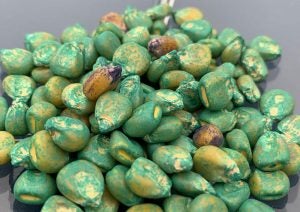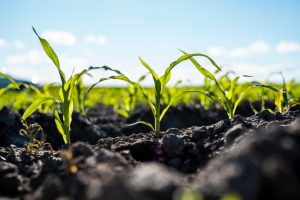When farmers get ready to plant, they’re faced with many decisions on what to do. One of those decisions is whether to plant treated seeds or untreated seeds. But this isn’t just a decision that faces production-scale farmers — gardeners also have the option to purchase treated versions of pumpkin seeds, pepper seeds, peas, squash seeds, corn, and more.
So what exactly are treated seeds and what is the difference between treated seeds and untreated seeds?
Treated seeds are seeds that have been lightly coated with various fungicides, insecticides, nematicides, and other biological products. Small amounts of these products are professionally applied to the seeds by seed companies or certified applicators. Treated seeds have a polymer coating to be sure the treatment adheres to the seed. After the treatment is applied, the seeds are a bright color to distinguish them from untreated seed.
The products that are applied help to protect plants from a variety of diseases and pests that attack the seed and seedlings after planting. These crop protection products help the seed when the benefits are most significant.

Non-treated seeds are what you normally think of when you think of seed. These seeds are not coated with fungicides, insecticides, nematicides, or any other biological products. This seed is clean and has certain labeling requirements at both the federal and state levels.
Each fungicide, nematicide, insecticide, or other biological product used as a seed treatment is each unique and targets a specific disease or pest. Different products are used as seed treatments based on where a farm is located, problems a farmer has faced in the past, weather, and even a farm’s budget.
One example of how treated seeds could help with weather can be found in the southern United States. In places where temperatures aren’t cold enough in winter to kill diseases or insects, seed treated for these diseases and insects can be extremely beneficial.
Treated seeds are used widely in the United States. A study from Pennsylvania State University and the U.S. Department of Agriculture found that from 2012 to 2014, 90 percent of corn acres and 76 percent of soybean acres were grown with treated seeds.
All treated seeds are thoroughly regulated and regularly reviewed by federal and state authorities. Treatments need to be approved by the Environmental Protection Agency before they can be added to the seeds. After these treatments are approved and added to seed, all treated seed has to follow strict labeling laws. The USDA requires that all treated seed be labeled with the name of the treatment and whether the seed cannot be used for food, feed, or oil purposes (or any of these individually).
The handling of treated seed is also regulated to minimize risk of pesticide exposure to people and the environment. If treated seed is spilled, it should be cleaned up to minimize the risk the treatment might have on wildlife, birds, fish, and even people. People handling treated seed should also follow the labeling guidelines on what personal protective equipment (PPE) to wear. If the seed has a label saying that it shouldn’t be used for food, feed, or oil purposes, you can trust that it won’t be. There is zero tolerance for treated seed being on the export market. Even a single treated seed could result in the rejection of an entire load of seeds.

Seed treatments offer an economical and sustainable way to boost food security. Treatments help to maximize yield potential, improve crop health and vigor, reduce the need for additional pesticide applications, and support sustainable agriculture. Without seed treatments, farmers sometimes have to use more intensive and costly farming practices to achieve the same results. This would require more tillage, fewer cover crops and more sprays of fungicides, insecticides, nematicides and other biological products.
Since treatments are applied directly to the seed, the amount of treatment used is minimal. This means there is a reduced possibility of runoff and reduced water quality when compared to traditional pesticide treatments.
Overall, treated seeds have been hugely innovative and have helped farmers to feed more people. They are a helpful tool that is used to feed a growing population by increasing yields, increasing profitability for farms, and even increasing sustainability of agriculture.
The great thing about farming today is that farmers have a choice. Farmers don’t have to use treated seed if they don’t want to. If they choose to use treated seed, they also have to choose what treatment will work best for their operation.
So, no matter whether you’re a farmer or a gardener, the next time you’re buying seeds (small scale or large scale), take a look at the huge variety of treated seeds available and take some time to decide what works best for you.
Michelle Miller, the “Farm Babe,” is an internationally recognized keynote speaker, writer, and social media influencer and travels full time to advocate for agriculture. She comes from an Iowa-based row crop and livestock farming background and now resides on a timber farm in North Central Florida.



